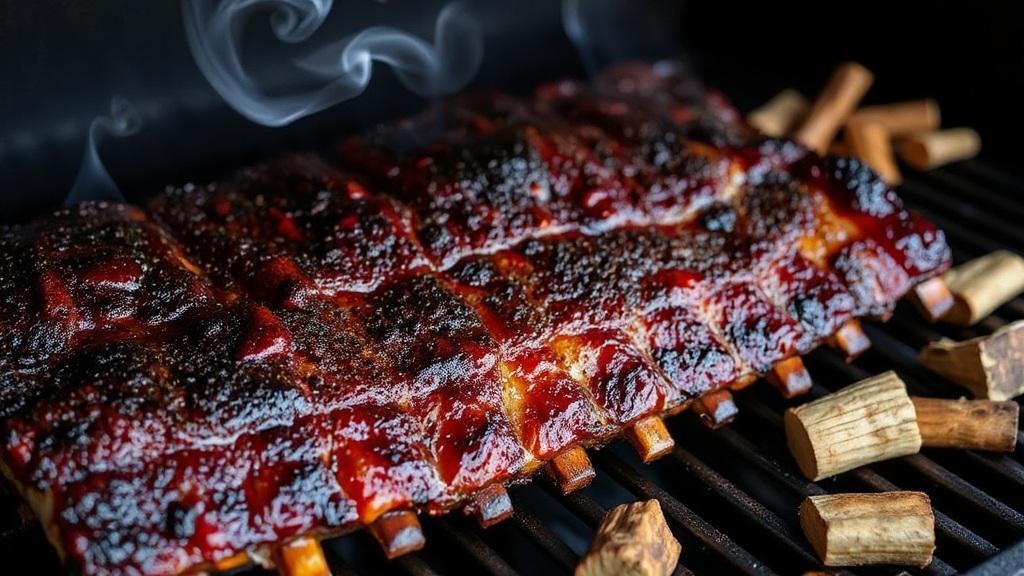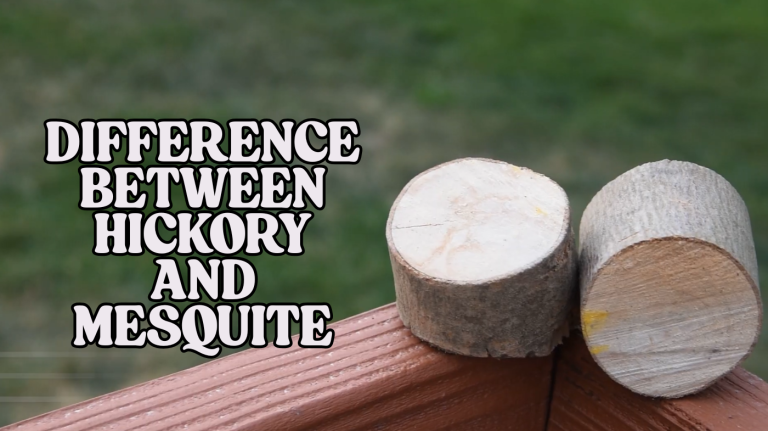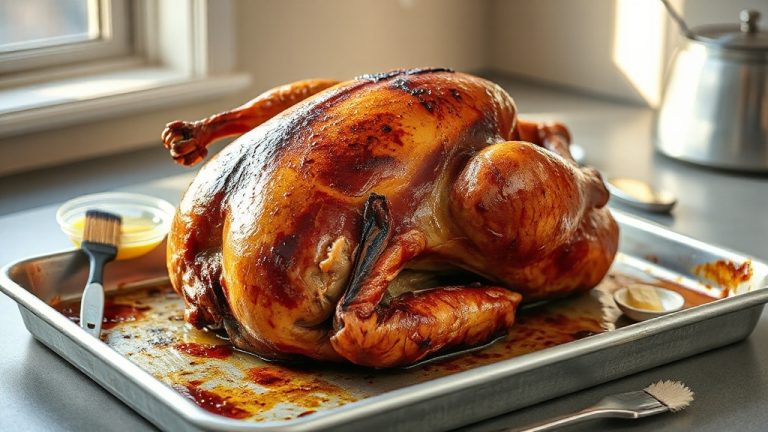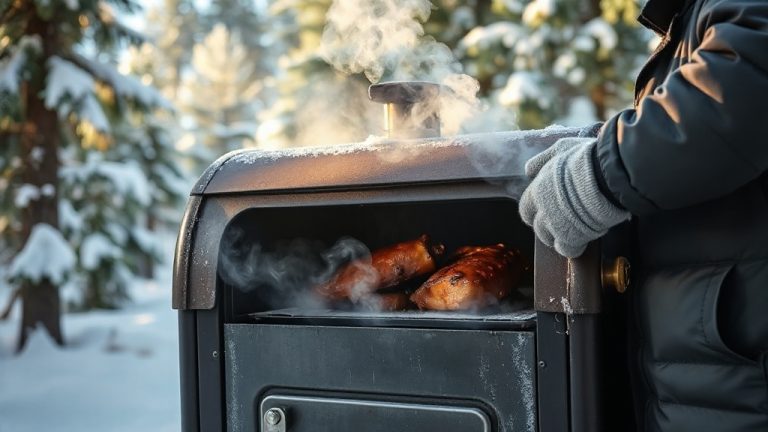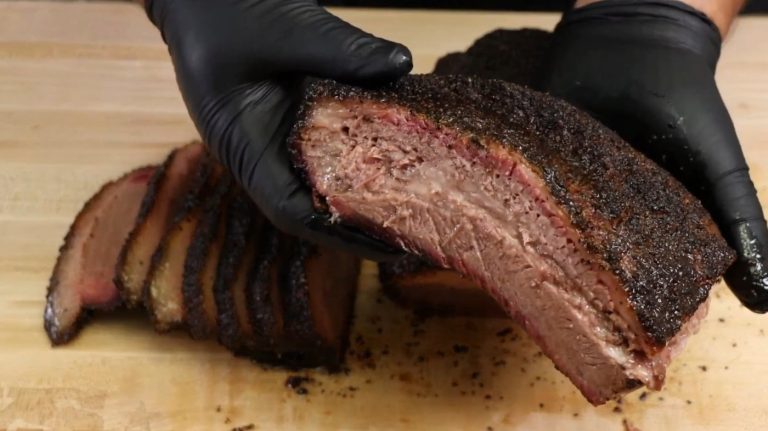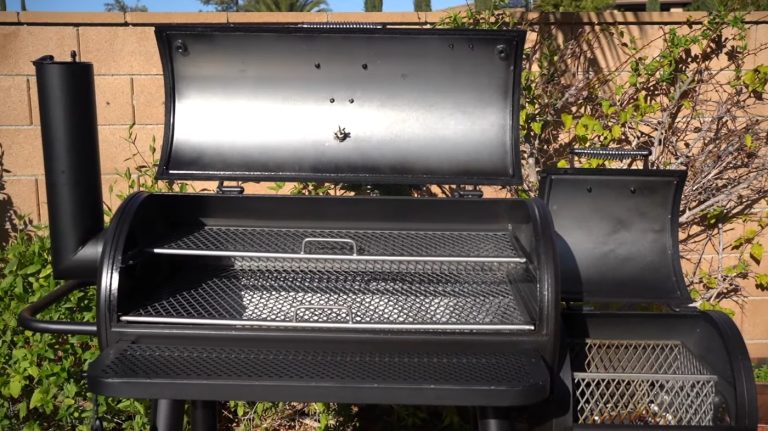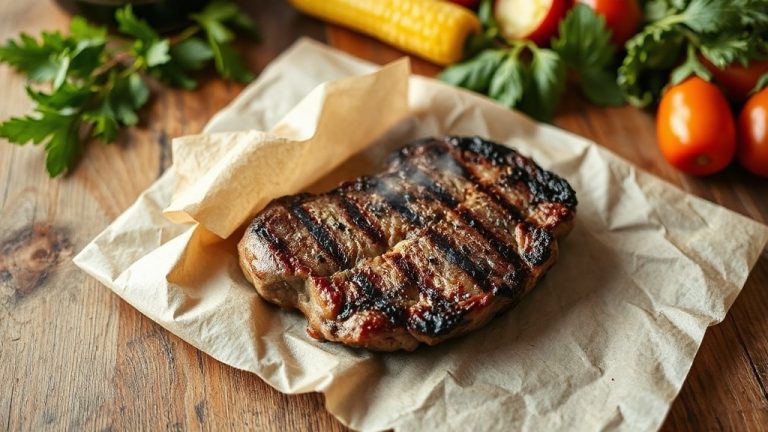How to Get Bark on Ribs? Pro Tips for a Crunchy Crust
To get bark on ribs, start by drying the meat surface well to form a tacky pellicle that helps your rub stick. Apply a balanced dry rub with sugar, salt, and spices, using yellow mustard as a binder.
Smoke ribs low and slow between 225°F and 250°F, keeping humidity controlled with a water pan and using flavorful wood like oak or cherry.
Let the bark set after cooking by resting the ribs. Keep going to uncover more proven tips and expert tricks.
Key Takeaways
- Dry ribs uncovered in the fridge for 1-2 hours to form a pellicle for better rub adhesion and bark development.
- Apply a mustard binder and a balanced dry rub with sugar, salt, and spices evenly before smoking.
- Maintain smoker temperature steady between 225°F and 250°F to promote caramelization and bark formation.
- Use hardwoods like oak, pecan, or cherry and keep smoke steady and consistent for deep flavor and bark color.
- Smoke ribs uncovered for several hours before wrapping to set the bark and avoid sogginess.
Preparing Ribs for Optimal Bark Formation
When preparing ribs for ideal bark formation, you’ll want to start by carefully managing moisture levels to strike the perfect balance between juiciness and bark crispness.
Begin by drying the rib surface thoroughly; this step is vital as it creates a pellicle, allowing the rub to stick better and develop a rich bark.
Start by drying ribs thoroughly to form a pellicle, ensuring rub adhesion and rich bark development.
Next, consider air drying the ribs uncovered in the refrigerator for an hour or two to enhance this effect. Using a water pan during smoking helps maintain ideal humidity, generating moist smoke that tenderizes the meat without sogging the bark.
When smoking, maintain ideal humidity by using a water pan; it generates moist smoke that tenderizes the meat without sogging the bark. Additionally, applying a spice rub containing sugar, salt, and spices helps enhance flavor and promotes crust development.
Keep the smoker temperature steady between 225°F and 250°F to avoid drying out the ribs or burning the bark. This precise moisture control sets the foundation for a flawless, flavorful bark.
Crafting the Perfect Dry Rub for Ribs
Although perfect bark starts with ideal smoking conditions, crafting the perfect dry rub is equally crucial for ribs that boast deep flavor and a textured crust.
Start by balancing brown sugar for caramelization without excess moisture. Combine kosher salt for flavor and moisture retention, smoked paprika for color and mild heat, and garlic and onion powders for savory depth.
Use mustard powder as a binder to help rub adhesion. A well-balanced dry rub enhances flavor without needing sauce, making the ribs flavorful on their own.
Mix ingredients thoroughly, breaking up sugar clumps, and apply evenly over a binder-coated surface just before cooking. The dry rub’s balance helps preserve the meat’s juiciness during cooking, ensuring a tender final product.
| Ingredient | Role |
|---|---|
| Brown Sugar | Sweetness, caramelization |
| Kosher Salt | Flavor enhancement, moisture |
| Smoked Paprika | Color, smokiness, mild heat |
Smoking Techniques to Develop a Deep Bark
Mastering the art of smoking ribs to develop a deep, flavorful bark demands precise temperature control; keeping your smoker steady between 225 and 250°F guarantees the perfect environment for the rub to caramelize without toughening or underdeveloping the crust.
Use a quality temperature probe at grate level and resist opening the smoker door frequently to maintain consistency. Maintaining consistent temperature is key to achieving the best bark texture.
Choose woods like oak, pecan, or cherry, adding just one dry chunk before placing ribs meat side up for balanced smoke without bitterness.
Position ribs away from direct heat and avoid overcrowding to ensure even airflow. Smoke uncovered for several hours before wrapping, allowing the bark to set firmly.
Avoid excessive spritzing early on, and keep ribs dry with a thin binder to promote crust adhesion and rich bark development.
Additionally, applying a thin, even layer of yellow mustard as a binder before seasoning helps the dry rub adhere better, which is crucial for achieving the ideal bark texture.
Managing Moisture and Smoke for Bark Quality
Since moisture and smoke play pivotal roles in developing a rich bark on ribs, you need to expertly balance both elements throughout the cooking process.
Start by allowing the meat’s surface to dry slightly, forming a tacky pellicle that helps rubs and smoke particles adhere effectively. This pellicle forms as proteins clump into tightly bonded matrices, providing an ideal surface for bark development.
Control humidity to prevent the bark from becoming soggy or cracking. Maintain low, steady smoke temperatures below 300°F to promote even smoke adhesion without burning. Using woods like apple or hickory can enhance flavor without overpowering the meat.
Remember, consistent smoke flow and duration deepen bark color and flavor.
- Dry the surface to create a pellicle
- Control humidity for ideal bark texture
- Maintain smoke temperature under 300°F
- Ensure steady, consistent smoke flow
- Extend smoke time for richer color and taste
Finishing Touches to Preserve and Enhance Bark
When you finish cooking ribs, handling them carefully is essential to preserve the bark’s complex flavors and crisp texture.
First, let the ribs rest briefly; this allows the bark to set and prevents moisture from softening it. Wrapping ribs in butcher paper instead of foil can help maintain the bark’s texture while allowing smoke to continue penetrating the meat.
Using a water pan during cooking can also help maintain moisture and temperature stability, contributing to better bark formation.
Store leftovers in airtight containers to lock in freshness and avoid sogginess. When reheating, use low heat to maintain the bark’s integrity—avoid microwaves or high temperatures that cause it to lose its crunch.
If you wrapped the ribs in butcher paper or foil, remove the wrap near the end of cooking to let the bark crisp up. Throughout, monitor temperature and avoid drastic fluctuations during cooking to enhance even bark formation.
Frequently Asked Questions
Can Bark Form on Ribs Cooked in an Electric Smoker?
Yes, you can definitely develop bark on ribs in an electric smoker. You’ll want to maintain a steady temperature between 225°F and 250°F. Use dry wood chips for clean smoke, and apply a rub rich in brown sugar and spices.
Keep the ribs dry before smoking, avoid opening the smoker early, and let them cook undisturbed. These steps help trigger the Maillard reaction, producing that flavorful, caramelized crust you’re after.
How Does the Type of Wood Affect Bark Flavor?
When you choose your wood, you’re inviting a symphony of flavors to dance on your ribs’ surface. Strong woods like hickory craft a bold, smoky bark, while fruit woods like apple or cherry gently whisper sweetness into the crust.
Mixing woods lets you choreograph a balanced bark—nutty, sweet, or robust. So, pick your wood thoughtfully; it shapes the bark’s flavor, texture, and the overall magic your ribs will deliver.
Is Bark Formation Different Between Baby Back and Spare Ribs?
Yes, bark formation differs between baby back and spare ribs. You’ll notice spare ribs develop a thicker, firmer bark due to their longer cooking time and higher fat content.
Baby back ribs, being leaner and smaller, form a more delicate bark that absorbs less smoke flavor. When you smoke, adjust your technique—spare ribs benefit from extended low-and-slow cooking, while baby backs need less time to achieve that perfect bark and tenderness.
Can Marinating Ribs Before Smoking Impact Bark Quality?
Marinating ribs before smoking can impact bark quality, but you can control it. Too much moisture keeps the surface wet, preventing that crispy bark you want.
Always pat your ribs dry after marinating and let them air-dry before applying rubs. Use marinades low in water and sugar to avoid a sticky, uneven crust. With proper drying and timing, you’ll get a beautiful bark that locks in flavor and texture.
How Long Can Ribs With Bark Be Stored Safely?
Like a treasured story, your ribs with bark stay fresh for about 4 days in the fridge if you refrigerate them within 2 hours after cooking.
To keep that bark crisp and flavor intact, store them in shallow containers or cut into portions to cool evenly. For longer storage, freeze them properly—vacuum seal if you can—to preserve that smoky bark magic up to 3 months without losing quality.
Master the Bark, Rule the BBQ
Achieving that perfect bark on ribs isn’t just luck—it’s science and technique combined. Did you know that ribs smoked at 225°F for 5-6 hours develop bark that’s 30% thicker and more flavorful than those cooked faster?
By prepping ribs properly, applying a well-balanced dry rub, controlling smoke and moisture, and finishing with care, you’ll create ribs with a bark that’s crispy, rich, and irresistible every time. Keep mastering these steps, and your ribs will steal the show.
